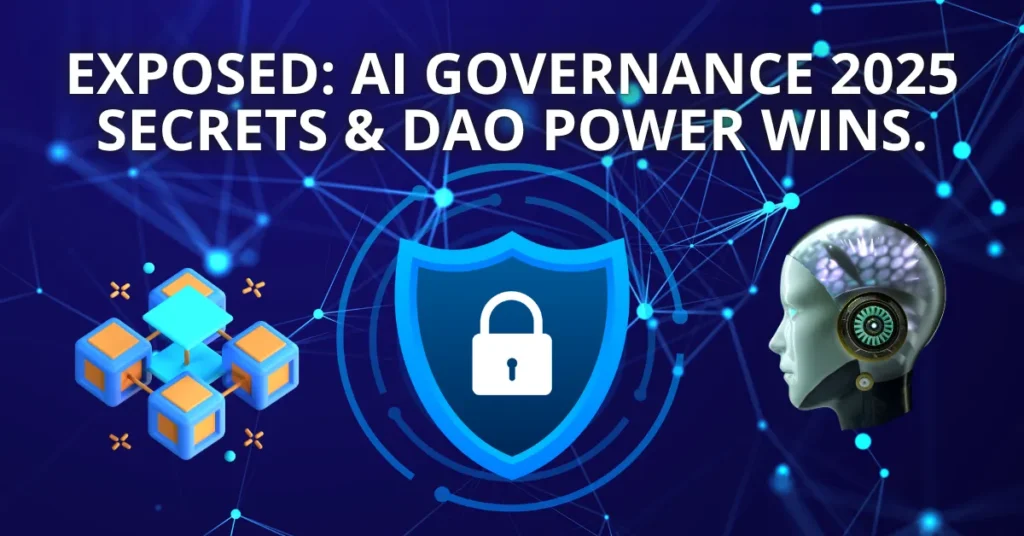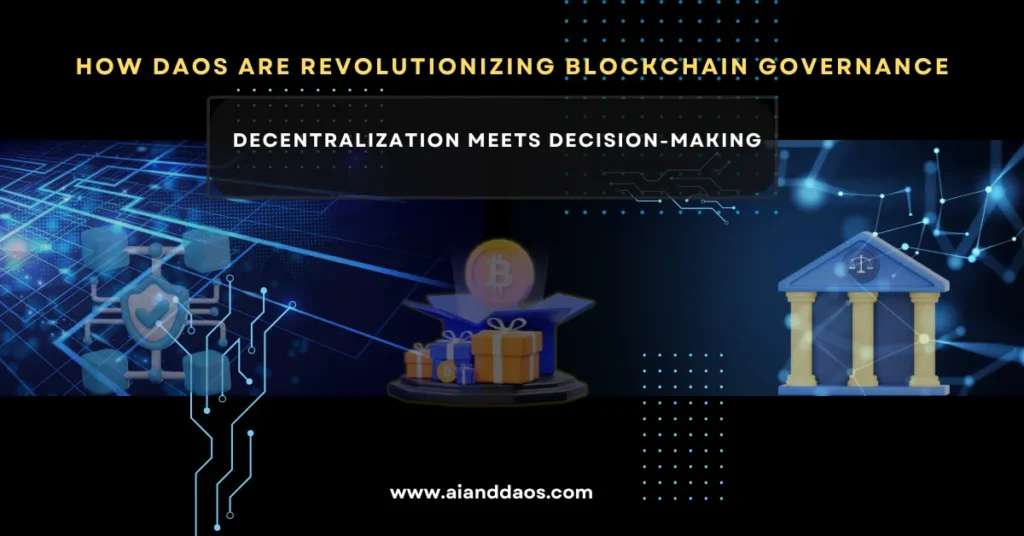Why 2025 Demands Smarter AI Governance
AI governance is more important than ever in 2025. As artificial intelligence becomes deeply integrated into decentralized autonomous organizations (DAOs), the risks of bias, misuse, and lack of transparency increase. DAOs rely on smart contracts and automation to operate without human control. Now, many are adding AI to handle tasks like voting, fund management, and proposal reviews.
Without clear rules and oversight, AI can make harmful or unfair decisions. The rapid growth of AI and new global regulations like the EU AI Act and U.S. policy frameworks drives this urgency. These changes demand more innovative, safer governance strategies.
Stronger AI governance ensures ethical use, transparency, and alignment with human values. To protect trust and avoid harm, both DAOs and enterprises must adopt responsible frameworks that balance innovation with accountability.
Top 5 DAO Governance Models in 2025: Choose the Best for Decentralized Success
Why AI Governance Matters in 2025
Artificial Intelligence is everywhere now. In 2025, it helps DAOs review proposals, companies screen job applications, and even hospitals prioritize patients. But as its role expands, so does the risk. Imagine if a job portal’s AI rejects a qualified applicant just because their name “sounds foreign.” This kind of bias isn’t science fiction—it has already happened. As AI systems increasingly make decisions without human checks, the need for smart governance becomes urgent.
These risks are no longer hidden or rare. Consider the AI tool used in U.S. courts that was found to recommend harsher sentences for Black defendants. Or the health insurance AI that wrongly denied treatment claims, putting patients at serious risk. These high-profile failures triggered public backlash and legal concerns. Now imagine a DAO using AI for treasury management or voting decisions—without oversight, it could silently make biased or harmful choices.
That’s why strong AI governance is critical. Think of it like traffic laws for intelligent systems. Just as seatbelts became mandatory after road accidents increased, we now need rules to prevent AI from causing harm. Good governance ensures that AI remains explainable, fair, and accountable—especially when it operates in high-stakes environments like finance, healthcare, or decentralized organizations.
Governments are responding with regulation. The EU AI Act now classifies systems used in areas like law enforcement and hiring as “high risk” and demands strict transparency. Meanwhile, in the U.S., the NIST AI Risk Management Framework provides a clear structure for developers to avoid ethical pitfalls. These are like safety checklists before launching a drone—applied to AI.
For DAOs and enterprises alike, this is a wake-up call. You wouldn’t let a new employee handle your organization’s finances without any rules—so why let AI? In 2025, AI governance isn’t just a best practice; it’s the foundation for earning trust, complying with law, and scaling responsibly in an AI-driven world.
Ethical Considerations in AI Governance
As AI systems take on more responsibilities—from recommending content to allocating healthcare—ethical concerns are growing louder. One of the biggest challenges is bias. AI often learns from historical data, which may include patterns of discrimination. For instance, an AI hiring tool trained on past resumes might prefer male candidates simply because previous hires were predominantly men. In such cases, the system is not just biased—it’s repeating and reinforcing old injustices.
Another critical concern is explainability. Many modern AI models, especially deep learning systems, operate like black boxes. Users don’t understand how they make decisions—and that’s dangerous. Imagine a DAO where AI decides which proposals get funded. If the community can’t trace the logic behind those decisions, trust breaks down. Transparency isn’t optional; it’s the foundation of accountability.
That’s where human oversight becomes essential. While automation speeds up processes, it must not replace ethical judgment. There should always be a mechanism for humans to question, override, or audit AI decisions. Think of it like a co-pilot system: the AI flies the plane, but the human ensures it doesn’t crash into ethical turbulence.
In 2025, the stakes are too high to leave ethics to chance. AI governance must ensure fairness, explainability, and human supervision—not just to meet legal standards, but to uphold human values in a world increasingly shaped by intelligent systems.
Risk Management in AI Systems
AI systems can be incredibly smart—but also dangerously flawed if not governed properly. In 2025, the risks are real, rising, and sometimes already causing damage. Here’s how DAOs can either manage or worsen these AI threats, and the tools they can use to stay safe:
Managing Data Leakage in DAO AI Systems
Imagine asking an AI customer service bot about a refund—and it accidentally reveals another customer’s private information. This isn’t hypothetical. In real cases, AI trained on unfiltered data began echoing sensitive details like emails or phone numbers in its responses. This kind of data leakage isn’t just embarrassing—it can violate data protection laws like GDPR and lead to lawsuits.
In 2025, DAOs are using AI chatbots and proposal analyzers to streamline operations. But when these tools are trained on unfiltered DAO data, a serious risk emerges—data leakage. This happens when private information unintentionally shows up in AI responses.
DAOs often operate transparently, but not all information should be public in AI responses. Wallet addresses, proposal notes, or discussion logs might be sensitive in certain contexts. Poor governance makes this risk worse—training AI on unredacted logs or skipping privacy checks can lead to leaks that violate trust or even legal compliance.
To reduce this risk, DAOs can use smart contracts that define on-chain privacy rules, restricting the AI’s access to only approved data. Community-approved data policies can also guide what content is safe to use for training.
A more robust approach is federated learning. Instead of collecting all DAO data in one place, each subgroup or node trains the model locally and shares only the learned patterns—not raw data. This limits exposure and ensures sensitive information never leaves its original context.
Technologies like ZKML (Zero-Knowledge Machine Learning) strengthen this further. ZKML allows an AI to prove it used valid, privacy-respecting inputs—without showing the actual data—giving DAO members confidence that their private actions remain confidential.
With smart governance, federated training, and privacy-focused AI tools, DAOs can embrace automation without putting sensitive data at risk.
Algorithmic Bias
Imagine a DAO uses an AI system to evaluate grant applications. Over time, the AI starts favoring proposals from certain regions or well-funded wallets, unintentionally sidelining underrepresented communities. This bias often stems from historical data patterns that the AI learns from—and if not addressed, it can embed systemic inequality into DAO decision-making.
DAOs operate on transparency, but they also tend to rely heavily on on-chain records. If the training data includes skewed outcomes (like funding going to a select few groups), the AI model may learn to repeat that bias. Without proper checks, a DAO’s automated systems could reinforce unfair patterns—blocking innovation and diversity in the ecosystem.
Poorly governed DAOs make this worse. If AI is trained on raw, unfiltered on-chain data and deployed without review, it can silently embed unfairness into the DAO’s decision-making process.
To prevent this, DAOs must build fairness checks into their governance workflows. Fairness Indicators—an open-source tool by Google—help measure how an AI model performs across different groups like gender, region, or wallet size. This tells the DAO if bias is baked in.
The What-If Tool adds another layer. It lets DAO members interactively test how the AI responds to changes—like swapping proposal origin or amount—to see if the decisions are consistent or skewed.
Once fairness is validated, ZKML (Zero-Knowledge Machine Learning) can prove that the AI made fair decisions—without exposing private data or inner workings.
And during training, Federated Learning ensures that data comes from a variety of DAO subgroups—not just dominant ones—reducing bias at the source.
This layered strategy helps DAOs use AI confidently while upholding fairness, privacy, and trust across the community.
Adversarial Attacks
A few altered pixels on a traffic sign can fool AI into misreading it entirely. Self-driving cars might mistake a stop sign for a speed limit sign. In the cybersecurity world, attackers are already using subtle changes to images or voice commands to trick AI—without humans noticing a thing.
In 2025, DAOs using AI for tasks like image moderation, proposal filtering, or document scanning face a serious challenge: adversarial attacks. These are subtle tweaks to input data—like slightly altered pixels or cleverly modified text—that can trick AI systems into making flawed decisions.
Imagine a malicious proposal slightly altered to bypass moderation or confuse an AI reviewer. If left unchecked, these inputs can lead to poor decisions, fund misallocation, or manipulation of DAO operations.
DAOs without proper AI governance are especially vulnerable. If their systems aren’t trained or monitored for adversarial behavior, they risk becoming easy targets for attackers looking to exploit AI weaknesses.
To tackle this, DAOs can adopt adversarial training, exposing models to tricky edge cases during development so they learn to resist such attacks. This forms the first line of defense.
Community-led red teaming is also crucial—where DAO members simulate attacks to identify vulnerabilities early. These real-world tests ensure the AI is stress-tested before deployment.
One of the most effective tools is Robustness Gym—an open-source toolkit that lets developers test model stability under adversarial conditions. DAOs can integrate this tool during the audit phase to benchmark resilience.
Before any AI model goes live, smart contract validators should enforce model integrity checks. These validators act as automated gatekeepers, ensuring only safe and verified models are deployed.
Together, Robustness Gym, adversarial training, community simulations, and contract-enforced checks help DAOs defend their AI systems and ensure fair, reliable governance at scale.
Enterprise AI Governance Strategies
Enterprise AI governance is no longer optional—it’s a competitive necessity. In 2025, companies across industries are embedding AI into core operations, from customer service automation to supply chain forecasting. To ensure these systems behave responsibly, organizations are building internal AI governance teams tasked with overseeing model lifecycle, ethics, compliance, and risk.
These teams typically collaborate with data science, legal, and compliance departments to set clear AI usage policies. A key part of their role is model accountability—tracking where models are deployed, who trained them, what data they use, and how decisions are made. This is where enterprise tools come in.
Companies now use ML observability tools like Arize or Fiddler to keep an eye on how their AI models perform. These tools help detect issues like model drift—when a model’s accuracy drops over time.
They also rely on model registries such as MLflow or Weights & Biases. These work like version control for AI. They store important details about each model—like who built it, what data it used, and how it was tested. By combining observability and registries, companies create a system that makes AI more transparent, traceable, and easier to manage. These tools are now a key part of enterprise AI governance.
To guide these efforts, many enterprises follow industry-recognized frameworks like Gartner’s AI Governance Model, which emphasizes four pillars: visibility, accountability, fairness, and robustness. Gartner recommends establishing AI steering committees, integrating ethical AI design principles, and enforcing policy compliance through both human and automated controls.
For example, a global retailer using AI to recommend products must not only track algorithm accuracy but also ensure it doesn’t discriminate based on user location or profile. With Gartner-aligned strategies, companies can meet both regulatory expectations and customer trust benchmarks.
Ultimately, enterprise AI governance blends people, tools, and policies into a responsible system that keeps innovation safe, fair, and aligned with long-term business goals.
AI Governance for DAOs
In DAOs, no central team controls the AI. This makes governance tricky. AI is often used to review proposals, manage funds, or moderate content. But without oversight, mistakes can go unnoticed.
Smart contracts add more pressure. These are codes that run actions based on AI decisions. For example, if the AI picks a top grant proposal, a smart contract may send funds right away. If the AI is biased or wrong, that decision still goes through—with no human to stop it.
That’s why voting is important. DAOs use governance tokens. Members vote on which AI to use, what data to train it with, and when to update or audit it. This keeps things democratic—but it only works if voters understand the risks.
Helpful tools make this easier. Dashboards can show how the AI works. Audit logs can track past decisions. Explainable AI tools help the community see why the AI made a choice.
For DAOs, good AI governance means more than just code. It means building trust with the community, adding safety checks, and using tools that make everything clear and fair. That’s how DAOs can stay safe while staying decentralized.
How to Implement AI Governance in Your DAO
Starting AI governance in a DAO doesn’t have to be complex. It begins with a shared vision. Draft an ethical charter—a short, clear document that outlines how your DAO will use AI. Include values like fairness, transparency, and privacy.
Next, add AI auditing tools to catch problems early. Tools like AI Fairness 360, Robustness Gym, or even custom logging can help detect bias, monitor performance drops, or flag unusual outputs from your AI models. These tools act like early warning systems—helping DAOs spot and fix issues before they affect important decisions.
Make your smart contracts explainable. This means designing them to show why they made a decision—whether it’s ranking proposals or releasing funds. That way, members can trace AI actions before they go live.
One powerful governance layer is community veto power. Use voting tools like Snapshot or DAOstack to let members pause or reject AI-driven proposals. This keeps human judgment in the loop.
To integrate AI safely, consider using OpenAI’s APIs with moderation filters and logs. Combine this with DAO-native platforms like DAOstack or Aragon to control how and when AI tools are used.
In short: start with clear values, audit your AI, make decisions traceable, and always give the community a say. That’s how to bring AI governance to life in any DAO—without losing the spirit of decentralization.
Future Trends in AI Governance for DAOs
As decentralized autonomous organizations (DAOs) mature, AI governance is rapidly evolving to meet future demands. In 2025 and beyond, expect DAOs to lean more heavily on AI—not just for automation, but for smarter decision-making and enhanced transparency.
One emerging trend is autonomous proposal vetting. Instead of relying solely on manual reviews, AI systems will be trained to evaluate proposals based on historical data, alignment with DAO goals, and potential impact. This saves time and ensures consistency—but also demands rigorous fairness checks to prevent bias or manipulation.
Another growing area is real-time sentiment analysis. Using natural language processing (NLP), DAOs will begin tracking member feedback across forums, chats, and social channels. This allows governance systems to detect rising concerns, identify community priorities, and even adjust proposal rankings dynamically—helping DAOs stay truly member-driven.
We’re also seeing a move toward blockchain-based AI audits. Every AI-driven decision can be logged immutably on-chain, making it possible to trace how and why an AI chose a certain path. This kind of auditability is essential for building trust and accountability in autonomous systems.
Projects like the Ethereum Foundation and dGov are already exploring decentralized frameworks where AI governance is built into the protocol layer. These initiatives aim to create tools that balance AI automation with human values—setting the standard for next-gen DAO infrastructure.
As these innovations unfold, future DAO governance will be faster, fairer, and more transparent—driven not just by code, but by community-aligned intelligence.
The Road Ahead for Responsible AI and DAOs
As AI continues to shape decisions in both DAOs and enterprises, the need for ethics, transparency, and accountability has never been greater. From avoiding bias and data leaks to ensuring fair decision-making, AI governance is no longer optional—it’s foundational.
For DAOs, where smart contracts and automation take the lead, responsible AI use ensures community trust and long-term resilience. For companies, internal governance teams and tools like model registries and audits help keep AI aligned with human values.
The message is clear: now is the time to adopt AI governance frameworks. Whether you’re a DAO builder or an enterprise innovator, responsible AI starts with proactive steps—because in 2025, trust is your greatest currency.
Common Questions on Governing AI in DAOs
Q1: What is the difference between AI governance and AI ethics?
A: AI ethics refers to the guiding principles that ensure AI systems are fair, transparent, and respect human rights. AI governance, on the other hand, is the framework of rules, tools, and processes used to implement and enforce those ethical principles in real-world AI systems. In short, ethics is the “why,” while governance is the “how.”
Q2: Why is AI governance important for decentralized systems?
A: In decentralized systems like DAOs, there’s no central authority to supervise AI decisions. This makes AI governance essential. It ensures transparency, accountability, and fairness by introducing community-driven audits, voting mechanisms, and on-chain rules that keep AI systems in check.
Q3: How are companies managing AI risk?
A: Companies manage AI risk using tools like model registries, fairness audits, explainable AI, and real-time monitoring platforms. They also follow global standards and frameworks such as the EU AI Act and the NIST AI Risk Management Framework to stay compliant and build trust.


